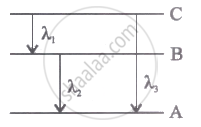Advertisements
Advertisements
प्रश्न
The total energy of an electron in the first excited state of the hydrogen atom is about −3.4 eV.
What is the potential energy of the electron in this state?
उत्तर
Potential energy (U) of the electron is equal to the negative of twice its kinetic energy.
⇒ U = −2 K
= − 2 × 3.4
= −6.8 eV
Hence, the potential energy of the electron in the given state is −6.8 eV.
संबंधित प्रश्न
A 12.5 eV electron beam is used to bombard gaseous hydrogen at room temperature. Upto which energy level the hydrogen atoms would be excited? Calculate the wavelengths of the first member of Lyman and first member of Balmer series.
A difference of 2.3 eV separates two energy levels in an atom. What is the frequency of radiation emitted when the atom makes a transition from the upper level to the lower level?
A hydrogen atom initially in the ground level absorbs a photon, which excites it to the n = 4 level. Determine the wavelength and frequency of the photon.
The total energy of an electron in the first excited state of the hydrogen atom is about −3.4 eV.
What is the kinetic energy of the electron in this state?
The total energy of an electron in the first excited state of the hydrogen atom is about −3.4 eV.
Which of the answers above would change if the choice of the zero of potential energy is changed?
Obtain the first Bohr’s radius and the ground state energy of a muonic hydrogen atom [i.e., an atom in which a negatively charged muon (μ−) of mass about 207 me orbits around a proton].
Wavelengths of the first lines of the Lyman series, Paschen series and Balmer series, in hydrogen spectrum are denoted by `lambda_L, lambda_P and lambda_B` respectively. Arrange these wavelengths in increasing order.
A 12.9 eV beam of electronic is used to bombard gaseous hydrogen at room temperature. Upto which energy level the hydrogen atoms would be excited ?
Calculate the wavelength of the first member of Paschen series and first member of Balmer series.
The energy levels of an atom are as shown below. Which of them will result in the transition of a photon of wavelength 275 nm?

Which transition corresponds to emission of radiation of maximum wavelength?
A Carnot engine absorbs 1000 J of heat energy from a reservoir at 127°C and rejects 600 J of heat energy during each cycle. The efficiency of the engine and temperature of the sink will be:
The Ionisation energy of hydrogen atom is 3.6 ev The ionisation energy of helium atom would be
Energy levels A, B, C of acertain atom corresponding to increasing value of energy, i.e., EA< E8 < Ee. If λ1, λ2 and λ3 are the wavelength of radiations corresponding to the transitions C to B, B to A and C to A respectively, which of the following statements is correct?

Two H atoms in the ground state collide inelastically. The maximum amount by which their combined kinetic energy is reduced is ______.
Radiation coming from transitions n = 2 to n = 1 of hydrogen atoms fall on He+ ions in n = 1 and n = 2 states. The possible transition of helium ions as they absorb energy from the radiation is ______.
Which of the following is true for X-rays?
